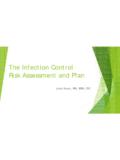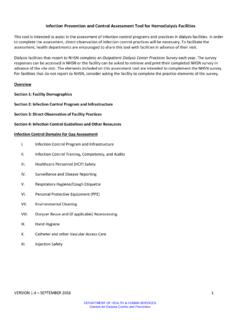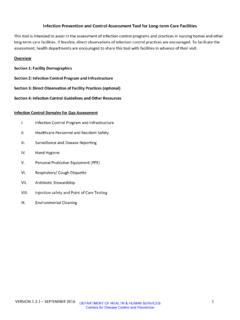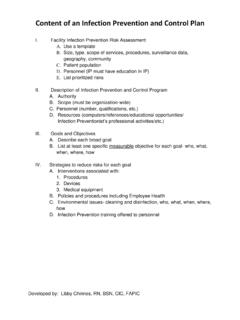Transcription of Infection Prevention, Control & Immunizations
1 Infection prevention , Control & Immunizations Infection Control : This facility task must be used to investigate compliance at F880, F881, and F883. For the purpose of this task, staff includes employees, consultants, contractors, volunteers, and others who provide care and services to residents on behalf of the facility. The Infection prevention and Control Program (IPCP) program must be facility-wide and include all departments and contracted services. If a specific care area concern is identified, it should be evaluated under the specific care area, such as for pressure ulcers, respiratory care, catheter care, and medication pass observations which include central lines, peripheral IVs, and oral/IM/respiratory medications. Coordination: One surveyor coordinates the facility task to review for: The overall Infection prevention and Control Program (IPCP); The annual review of the IPCP policies and practices; The review of the surveillance and antibiotic stewardship programs; and Tracking influenza/pneumococcal immunization of residents.
2 Team assignments must be made to include the review of: Laundry services; A resident on transmission-based precautions, if any; Five sampled residents for influenza/pneumococcal Immunizations ; and Other care-specific observations if concerns are identified. Every surveyor assesses IPCP compliance throughout the survey and communicates any concerns to the team. Hand Hygiene: Staff implement standard precautions ( , hand hygiene and the appropriate use of personal protective equipment (PPE)). Appropriate hand hygiene practices are followed. Alcohol-based hand rub (ABHR) is readily accessible and placed in appropriate locations. These may include: Entrances to resident rooms; At the bedside (as appropriate for resident population); In individual pocket-sized containers by healthcare personnel; Staff work stations; and Other convenient locations. Staff wash hands with soap and water when their hands are visibly soiled ( , blood, body fluids), or after caring for a resident with known or suspected C.
3 Difficile Infection (CDI) or norovirus during an outbreak, or if endemic rates of CDI are high. ABHR is not appropriate to use under these circumstances. Staff perform hand hygiene (even if gloves are used) in the following situations: Before and after contact with the resident; CMS-20054 (5/2017) Page 1 After contact with blood, body fluids, or visibly contaminated surfaces or other objects and surfaces in the resident s environment; After removing personal protective equipment ( , gloves, gown, facemask); and Before performing a procedure such as an aseptic task ( , insertion of an invasive device such as a urinary catheter, manipulation of a central venous catheter, and/or dressing care). When being assisted by staff, resident hand hygiene is performed after toileting and before meals.
4 Interview appropriate staff to determine if hand hygiene supplies are readily available and who they contact for replacement supplies. Soap, water, and a sink are readily accessible in appropriate locations including, but not limited to, resident care areas, food and medication preparation areas. 1. Did staff implement appropriate hand hygiene? Yes No F880 Personal Protective Equipment (PPE): Determine if staff appropriately use and discard PPE including, but not limited to, the following: Gloves are worn if potential contact with blood or body fluid, mucous membranes, or non-intact skin; Gloves are removed after contact with blood or body fluids, mucous membranes, or non-intact skin; Gloves are changed and hand hygiene is performed before moving from a contaminated body site to a clean body site during resident care; A gown is worn for direct resident contact if the resident has uncontained secretions or excretions; A facemask is worn if contact ( , within 3 feet) with a resident with new acute cough or symptoms of a respiratory Infection ( , influenza-like illness).
5 Appropriate mouth, nose, and eye protection ( , facemasks, face shield) is worn for performing aerosol-generating and/or procedures that are likely to generate splashes or sprays of blood or body fluids; PPE is appropriately discarded after resident care, prior to leaving room, followed by hand hygiene; and Supplies necessary for adherence to proper PPE use ( , gloves, gowns, masks) are readily accessible in resident care areas ( , nursing units, therapy rooms). Interview appropriate staff to determine if PPE supplies are readily available and who they contact for replacement supplies. 2. Did staff implement appropriate use of PPE? Yes No F880 Transmission-Based Precautions: Determine if appropriate transmission-based precautions are implemented, including but not limited to: PPE use by staff ( , don gloves and gowns before contact with the resident and/or his/her environment while on contact precautions; don facemask within three feet of a resident on droplet precautions; don a fit-tested N95 or higher level respirator prior to room entry of a resident on airborne precautions.)
6 CMS-20054 (5/2017) Page 2 Infection prevention , Control & Immunizations Dedicated or disposable noncritical resident-care equipment ( , blood pressure cuffs, blood glucose monitor equipment) is used, or if not available, then equipment is cleaned and disinfected according to manufacturers instructions using an EPA-registered disinfectant prior to use on another resident; The least restrictive TBP possible under the circumstances; Objects and environmental surfaces that are touched frequently and in close proximity to the resident ( , bed rails, over-bed table, bedside commode, lavatory surfaces in resident bathrooms) are cleaned and disinfected with an EPA-registered disinfectant for healthcare use at least daily and when visibly soiled. Interview appropriate staff to determine if they are aware of processes/protocols for transmission-based precautions and how staff is monitored for compliance.
7 If concerns are identified, expand the sample to include more residents with transmission-based precautions. 3. Did the staff implement appropriate transmission-based precautions? Yes No F880 NA Laundry Services: Determine whether staff handle, store, and transport linens appropriately including, but not limited to: Using standard precautions ( , gloves) and minimal agitation for contaminated linen; Holding contaminated linen and laundry bags away from his/her clothing/body during transport; Bagging/containing contaminated linen where collected, and sorted/rinsed only in the contaminated laundry area (double bagging of linen is only recommended if outside of the bag is visibly contaminated or is observed to be wet on the outside of the bag); Transporting contaminated and clean linens in separate carts; if this is not possible, the contaminated linen cart should be thoroughly cleaned and disinfected per facility protocol before being used to move clean linens.
8 Clean linens are transported by methods that ensure cleanliness, , protect from dust and soil; Ensuring mattresses, pillows, bedding, and linens are maintained in good condition and are clean (Refer to F584); and If a laundry chute is in use, laundry bags are closed with no loose items. Laundry Rooms Determine whether staff: Maintain/use washing machines/dryers according to the manufacturer s instructions for use; If concerns, request evidence of maintenance log/record; and Use detergents, rinse aids/additives, and follow laundering directions according to the manufacturer s instructions for use. 4. Did the facility store, handle, transport, and process linens properly? Yes No F880 CMS-20054 (5/2017) Page 3 Infection prevention , Control & Immunizations Infection prevention , Control & Immunizations Policy and Procedure: The facility established a facility-wide IPCP including written IPCP standards, policies, and procedures that are current and based on national standards.
9 The policies and procedures are reviewed at least annually. Concerns must be corroborated as applicable including the review of pertinent policies/procedures as necessary. Yes No F880 5. Did the facility develop and implement an overall IPCP including policies and procedures that are reviewed annually? Infection Surveillance: The facility has established/implemented a surveillance plan, based on a facility assessment , for identifying, tracking, monitoring and/or reporting of infections . The plan includes early detection, management of a potentially infectious, symptomatic resident and the implementation of appropriate transmission-based precautions. The plan uses evidence-based surveillance criteria ( , CDC NHSN Long-Term Care or revised McGeer Criteria) to define infections and the use of a data collection tool . The plan includes ongoing analysis of surveillance data and review of data and documentation of follow-up activity in response.
10 The facility has a process for communicating the diagnosis, antibiotic use, if any, and laboratory test results when transferring a resident to an acute care hospital or other healthcare provider; and obtaining pertinent notes such as discharge summary, lab results, current diagnoses, and Infection or multidrug-resistant organism colonization status when residents are transferred back from acute care hospitals. The facility has a current list of reportable communicable diseases. Staff can identify to whom and when communicable diseases, healthcare-associated infections (as appropriate), and potential outbreaks must be reported. Prohibiting employees with a communicable disease or infected skin lesions from direct contact with residents or their food, if direct contact will transmit disease. Interview appropriate staff to determine if Infection Control concerns are identified, reported, and acted upon. 6. Did the facility provide appropriate Infection surveillance?















